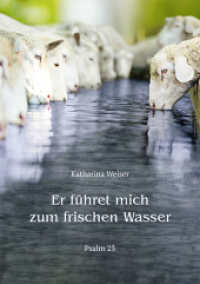- ホーム
- > 洋書
- > 英文書
- > Science / Mathematics
Full Description
In the development of Fundamental Physics on one side, and of Astronomy/Cosmology on the other side, periods of parallell, relatively independent progress seem to alternate with others of intense interaction and mutual influence. To this latter case belong the very beginnings of Modern Physics, with Galileo and Newton. There is now a widespread feeling that another of such flourishing periods may have started some ten years ago, with the advent of Unified Theories and the introduction of Inflationary Cosmologies. The interaction between the two disciplines has become tighter ever since, spurring studies of e. g. astronomical and particle Dark Matter candidates, Superstrings and Cosmic Strings, phase transitions in the Early Universe, etc. etc. Then the recent birth of Neutrino Astronomy has added further flavor to this splendid conjunction. It was indeed with the clear perception of this trend that six years ago CERN and ESO decided to jointly organize a series of symposia focusing on the interactions between Astronomy, Cosmology, and Fundamental Physics, to be held about every two years. The aim of these meetings is to bring together astronomers, cosmologists, and particle physicists to exchange information, to discuss scientific issues of common interest, and to take note of the latest devolopments in each discipline that are relevant to the other. The First ESO-CERN Symposium was held at CERN (Geneva) on November 21-25, 1983. Then for its Second edition the ESO-CERN Symposium moved to Garching bei Miinchen, where ESO headquarters are located, and took place on March 17-21, 1986.
Contents
Astroparticle Physics (1988).- Cosmological Parameters of the Universe.- Electroweak Physics in 1988.- Lithium-7 as a Cosmological Observable.- Recent Results from the e+e- Colliders TRISTAN and CESR.- The Large-Scale Distribution of Galaxies.- The Cosmic Microwave Background Radiation and the Dog in the Night.- Quark Deconfinement and J/? Suppression in Nuclear Collisions.- A Brief Status Report on the SLAC Linear Collider (SLC).- The Large Scale Structure of the Universe.- Status and Physics of the FERMILAB TEVATRON.- Cosmic Strings and Galaxy Formation: Overview and Recent Results.- Results from the Frejus Experiment.- Superclusters of Galaxies: Fractal Properties.- Underground Physics.- Probing the Universe with Rich Clusters of Galaxies as Giant Gravitational Telescopes.- Dark Matter in Astronomy.- Dark Matter Candidates.- Limits on Wimps from Globular Cluster Stars.- Improved Limits from the Galactic Axion Search.- Low Temperature Detectors for Neutrinos and Dark Matter.- Is there Dark Matter in Elliptical Galaxies?.- Special Session on Supernova 1981A.- Optical Studies of the Supernova 1987A.- Neutrino Astrophysics: Its Birth and Future.- Models of Type II Supernovae and Supernova 1987A.- X-Ray Observation of SN1987A from Ginga.- Models for the X-Ray Emission from Supernova 1987A.- Beyond the Standard Model.- High Redshift Objects.- Concluding Lecture.- Posters.- Hard X-Ray Observation of the Supernova 1987A.- The UA6 Experiment at the CERN Collider.- Precise Determination of the Background Radiation Temperature.- An Age Estimate for the NGC456, 460 and 456 SMC Constellations.- On the Orientation of Spiral Galaxies in the Perseus Supercluster.- Thermal Coupling of the CMBR and the Primordial Gas in the Post-Recombination EPOCH (z ? 1000).- Nearby SpiralGalaxies: Optical and Radio Properties.- Recent Results on Detector Developments for Low Energy Solar Neutrinos and Dark Matter: SSG and DSC Devices.- New Estimates for the C/M Ratio.- Small Scale Isotropy of the Cosmic Microwave Background at 230 GHz.- Predictable Chemistry of Systems Containing Unsaturated Quarks.- The OPAL Detector at LEP.- Measurement of TCBR AT 1.3 mm.- Correlations Between Records of Neutrino and Gravitational Wave Detectors During SN1987A.- CBR Fluctuations at Different Wavelengths.- Temperature Relation at a Deflagration Hadronization Front.- Search for CBR Anisotropies and Observations of the Magellanic Clouds at Millimetric Wavelengths.- Primordial Nucleosynthesis: The Effects of Injecting Hadrons.- Power-Law Spectra and the Large Scale Pattern of the CMB.- Observations of Cosmic Fluctuations.- Neutrino Emission from Supernovae in the Presence of Magnetic Fields.- Inflation-Produced, Large-Scale Magnetic Fields.- A New Detector Scheme for Axions.








